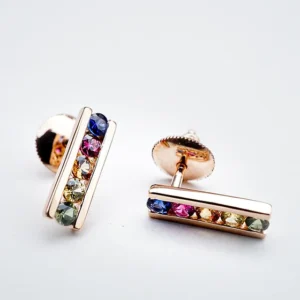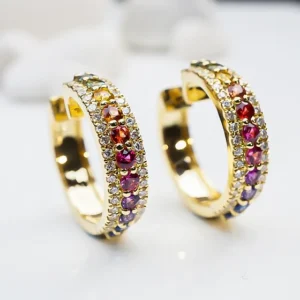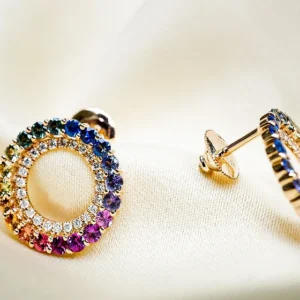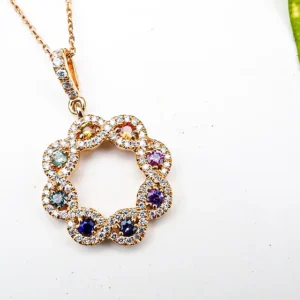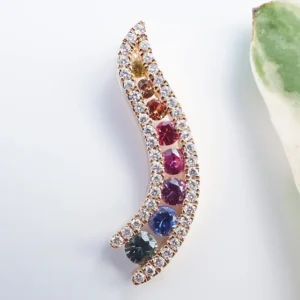Heart Cut Diamonds: Unveiling Romance and Elegance
Diamonds have long been hailed as symbols of eternal love and beauty. Among the various diamond cuts, the heart cut, also known as the heart shaped diamond, stands out for its unique shape and romantic allure. In this article, we’ll delve into the world of heart cut diamonds, exploring their history, characteristics, popularity, and how to choose the perfect heart diamond for your special moment.
Table of Contents
Heart Cut Diamonds
A heart cut diamond, brilliantly reflecting light from its facets.
Introduction
When words fail to capture the profound emotions that reside within one’s heart, heart cut diamonds, also commonly known as a heart shaped diamonds, emerges as an eloquent messenger of deep-seated love and boundless affection.
This exquisite diamond cut, painstakingly shaped to mirror the timeless symbol of love that universally resonates, injects an enchanting aura into every facet of its being.
Whether adorning engagement rings that symbolize the promise of forever, gracing necklaces that hold memories close to the heart, or finding its place in delicate pendants that encapsulate cherished moments, heart cut diamonds possess an innate ability to infuse a dash of enchantment and wonder into every piece of jewelry it graces.
The Artistry Behind Heart Cut Diamonds
Crafting a heart cut diamond, is an intricate art form that demands a level of skill and precision that is truly unparalleled. In the hands of master diamond cutters, each stone undergoes a meticulous transformation, as they delicately sculpt it into two perfectly symmetrical halves, meticulously mirroring the iconic silhouette of a heart.
This endeavor to achieve impeccable symmetry serves as a profound testament to the cutter’s exceptional expertise, for even the tiniest deviation from flawlessness can reverberate throughout the diamond’s entirety, impacting the way it captures and reflects light, ultimately influencing its unparalleled brilliance that enchants beholders.
A Brief History of Heart Cut Diamonds
The rich history of the heart cut diamonds can be traced back to the romantic landscape of the 16th century, where a tale of devotion unfolds as Mary Queen of Scots bestowed upon her beloved a heart-shaped diamond ring—an exquisite token of her affection that laid the foundation for the enchanting realm of romantic jewelry.
However, it was the 20th century that witnessed the heart diamond cut’s ascent to popularity, owing its rise to the adept hands of skilled diamond cutters who painstakingly honed and perfected the technique.
Their dedication to enhancing the cut’s intricate details, refining its proportions, and amplifying its brilliance breathed new life into the heart-shaped diamond, transforming it into a timeless symbol of love that continues to capture hearts across generations.
Characteristics That Captivate Hearts
A Shape Unlike Any Other
Heart cut diamonds, possess an unmistakable identity that sets it apart with a glance. Its distinctive form, characterized by a captivating cleft and elegantly arched lobes, stands as a testament to the intricate craftsmanship demanded to attain the coveted heart shape.
Every facet and contour demands meticulous precision as skilled artisans meticulously shape the diamond, ensuring that each curve harmoniously intertwines with the next.
This precision goes beyond mere aesthetics, for it plays a pivotal role in dictating the diamond’s brilliance and sparkle, turning it into a mesmerizing embodiment of affection and charm that captures the imagination and admiration of all who behold it.
Brilliance and Fire
Heart cut diamonds, possess an inherent ability to transform light into a breathtaking dance of brilliance and fire when meticulously proportioned. The carefully sculpted facets, strategically positioned across the diamond’s surface, work in perfect harmony to intercept incoming light rays, guiding them through a mesmerizing journey of reflection and refraction.
This intricate interplay of light results in a captivating display of scintillation that seems to breathe life into the stone.
The heart cut diamond’s symmetrical lobes and precisely defined cleft act as conduits for luminosity, ensuring that every flicker of radiance is harnessed to create a spectacle that enchants onlookers and bathes the surrounding environment in a captivating and ever-changing shimmer.
Setting Styles to Enhance the Cut
Selecting the perfect setting for a heart cut diamonds, is an art that can magnify its allure to breathtaking levels. The choice of setting can significantly influence how the diamond interacts with light, ultimately shaping its radiance and brilliance. Among the array of options, prong settings stand out as a masterful choice, allowing light to gracefully permeate the diamond from all angles.
These delicate metal claws not only hold the diamond securely in place but also ensure that its facets remain unobstructed, enabling an unimpeded passage for light to penetrate and refract.
As sunlight or ambient illumination gracefully cascade over the diamond’s surface, the prong setting collaborates harmoniously with the diamond’s precise geometry, orchestrating a dazzling symphony of sparkle that casts an enchanting aura on the wearer and her surroundings.
Popularity and Symbolism of Heart Cut Diamonds
Heart cut diamonds popularity has ascended to soaring heights, propelled by its embodiment of deep and enduring love, rendering it a highly coveted selection for engagement rings and anniversary tokens.
As an emblem of affection, its symbolism speaks volumes, encapsulating the profound connection shared by two souls. This timeless allure, entwined with an inherent romantic charm, creates an irresistible draw that transcends cultural boundaries, resonating with couples across the globe.
The heart cut diamond’s ability to encapsulate not only the brilliance of the gem itself but also the essence of affection makes it a cherished choice, embodying the promise of love’s eternal journey and serving as an enduring testament to the most cherished milestones of life.
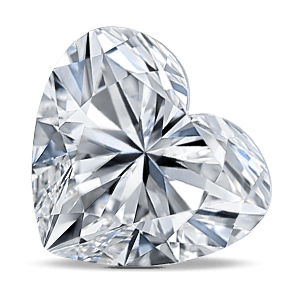
Heart Cut Diamond
Choosing the Perfect Heart Shaped Diamond
Carat Weight Considerations
The art of choosing the perfect carat weight for a heart diamond is a delicate balance that intertwines personal preference and budget considerations. The decision takes on a profound significance, as the carat weight not only influences the diamond’s size but also the prominence of its iconic heart shape.
For those drawn to a bolder and more pronounced heart silhouette, opting for a larger carat weight can be an inspired choice.
As the diamond’s dimensions increase, the heart’s contours become more distinct, amplifying its visual impact and making a striking statement. However, the choice ultimately rests upon individual sensibilities and financial considerations, ensuring that each heart diamond’s significance is as unique as the love it represents.
Color Grading Insights
The influence of diamond color on the appearance of heart cut diamonds is profound, dictating its overall visual impact. Opting for a near-colorless grade is a strategic choice, as it accentuates the diamond’s inherent brilliance and luminosity.
When paired with a white gold or platinum setting, the diamond’s radiance is elevated to new heights, creating a harmonious synergy between the gem’s scintillating play of light and the cool, reflective tones of the metal.
This careful curation of color and setting results in a masterpiece of elegance and sophistication, where every facet of the heart diamond gleams with a captivating radiance that captures the essence of timeless allure.
Clarity: Seeing Through the Facets
Heart cut diamonds boasting higher clarity grades offer an enchanting spectacle, showcasing a reduced presence of imperfections that paves the way for a spellbinding sparkle.
As light dances through the facets of the diamond, the absence of significant flaws allows it to refract and reflect seamlessly, unhindered by inclusions that might otherwise obstruct its dazzling journey.
This clarity-driven brilliance transforms the heart diamond into a captivating showpiece, where each flicker of light becomes a testament to the gem’s purity, drawing the gaze and igniting a sense of wonder in those fortunate enough to behold its scintillating beauty.
Cut: The King of Diamond's Allure
At the heart of heart cut diamonds allure lies its cut, a paramount factor that governs its inherent beauty. The significance of a well-proportioned cut cannot be overstated, as it serves as the conduit for the diamond’s interaction with light. A cut that is meticulously calibrated ensures that light penetrates the gem at precise angles, enabling it to bounce off each facet with remarkable intensity.
This symphony of light play engenders a mesmerizing scintillation that seems to breathe life into the diamond, casting an enchanting spell that captivates onlookers. The cut, beyond being a mere technical aspect, metamorphoses into a work of art—a catalyst that unleashes the diamond’s radiance and grants it the power to mesmerize and inspire, much like love itself.
Caring for Your Heart Diamond
Preserving the resplendence of heart cut diamonds demands consistent care and thoughtful storage. To ensure its enduring sparkle, a delicate regimen involving gentle cleansing and meticulous maintenance is paramount. With a touch of tenderness, a mild cleanser and a soft, non-abrasive brush can be employed to whisk away the accumulated residues that obscure its brilliance.
As time’s embrace unfolds, and life’s adventures are embarked upon, safeguarding the diamond’s allure becomes a cherished commitment—an ode to the enduring beauty of love, mirrored within the heart diamond’s scintillating facets, waiting to shine anew with every loving touch and gesture.
Heart Cut Diamonds vs. Other Fancy Shapes
Amidst the prevailing dominance of round brilliant diamonds within the market, heart cut diamonds emerge as a striking alternative—a radiant expression of individuality and distinction. For those who yearn to tread a path less traveled, the heart cut diamond presents an opportunity to fuse timeless tradition with an exquisite touch of uniqueness.
It encapsulates the essence of romance while embracing a bold departure from convention, infusing an air of unconventionality into the realm of diamond selection.
The heart diamond, with its silhouette that mirrors the most profound emotions, becomes more than a gem; it metamorphoses into a narrative, resonating with those who seek not just a diamond, but a symbol that echoes their singular journey of love.
Customizing Heart Shaped Diamond Jewelry
Embracing the realm of custom jewelry design provides a canvas to unveil your distinctive style and tell your unique story. In this creative endeavor, heart cut diamonds become the focal point of an artistic narrative, lending themselves seamlessly to a spectrum of settings that span the continuum from vintage to modern.
Whether nestled within the intricate lacework of a vintage-inspired design or gracing the clean lines of a contemporary masterpiece, the heart diamond transcends eras, lending its emotive symbolism to the vision you wish to encapsulate within a wearable masterpiece.
The act of crafting custom jewelry becomes a harmonious collaboration between gem and creator, inviting the manifestation of personal taste and sentiment into an extraordinary form that elegantly resonates with the heart’s deepest desires.
Incorporating Heart Diamonds into Different Settings
Solitaire Rings
Solitaire rings, with their unassuming elegance, create a symphony of minimalist allure that draws attention to the very heart of the jewel—the diamond itself. As the embodiment of refined simplicity, a heart shaped diamond perched atop a solitaire setting transforms the ring into a poetic expression of love’s essence.
The solitary gem becomes a mesmerizing focal point, commanding attention with every gleam of light that dances across its facets. The absence of elaborate embellishments places the heart diamond in the spotlight, allowing its emotive power to shine undisturbed.
This classic design encapsulates a timeless beauty that speaks to the purity of affection and the depth of connection, making it a cherished choice for those who seek to whisper their love through understated yet resounding elegance.
Halo Settings
Halo rings, a marriage of sophistication and radiance, bestow an ethereal luminosity upon the heart shaped diamond they embrace. The heart diamond takes center stage within a mesmerizing ensemble of smaller, twinkling gemstones that form a halo around its contours. This orchestration of brilliance not only amplifies the diamond’s luminosity but also imparts an aura of grandeur that envelopes the wearer’s finger.
The heart diamond, nestled within this celestial constellation, becomes a luminary that captures the essence of romance itself. The halo design infuses an air of opulence and extravagance, while at the same time, accentuating the heart diamond’s symbolic significance—a testament to love’s radiant and enduring splendor.
Three-Stone Settings
Three-stone rings, a poignant embodiment of the past, present, and future, offer a heartfelt narrative that resonates deeply with the journey of love. With a heart shaped diamond at its core, flanked by two accompanying gemstones, this design becomes a poignant visual representation of the enduring connection shared between two souls.
The heart diamond, standing as a symbol of the present, is embraced by the other stones that represent the memories that precede it and the promises that lie ahead.
This arrangement invites contemplation upon the shared story, capturing the essence of unity and evolution. The heart diamond, as the focal point of this trio, becomes an exquisite testament to the enduring strength of love—rooted in cherished history, pulsating in the present moment, and eagerly anticipating the future’s embrace.
Incorporating Heart Cut Diamonds into Jewelry
Heart Cut Engagement Rings
Heart cut engagement rings, a poetic proclamation of affection, redefine the traditional realm of commitment with their emblematic silhouette. Nestled within the contours of these rings, a heart shaped diamond takes on a new role—not merely as a precious gem, but as a tangible representation of the love that binds two individuals.
This design choice transforms the engagement ring into a profound declaration of emotion, reflecting the wearer’s distinctive personality and the depth of their relationship.
As light dances upon the heart diamond’s facets, it conjures a kaleidoscope of brilliance that mirrors the myriad nuances of love itself. The heart cut engagement ring is not only an exquisite adornment but a radiant embodiment of a shared journey, making it an extraordinary choice for those who wish to immortalize their commitment in a unique and enchanting manner.
Necklaces and Pendants
Necklaces and pendants adorned with heart cut diamonds emerge as exquisite tokens of affection that draw attention to the delicate curve of the neck and the heart’s center. When suspended from a chain, the heart diamond becomes a luminary that gracefully captures and reflects the light, creating an ethereal aura that radiates with every movement.
These pieces transcend the realm of mere accessories, evolving into wearable expressions of emotion and connection. A heart shaped diamond, delicately nestled against the wearer’s skin, infuses each moment with a touch of romance, reminding them of the cherished bond they carry close to their heart.
Whether given as a gift or worn as a personal keepsake, necklaces and pendants adorned with heart diamonds resonate as symbols of love’s enduring beauty, making them an unforgettable gesture that resonates deeply, defying the need for words.
Earrings
Earrings embellished with heart cut diamonds offer a captivating interplay of elegance and movement, framing the face with a radiant sophistication. As these delicate gems sway with every gesture, they become dynamic reflections of the wearer’s grace and emotion.
The heart diamonds, suspended from the earlobes, catch the light from all angles, creating a dazzling symphony of sparkle that illuminates the complexion and draws attention to the eyes. These earrings are more than mere accessories; they embody the wearer’s spirit and individuality, transforming any ensemble into an ensemble into a work of art.
Whether adorning the ears for a special occasion or adding a touch of glamour to everyday life, heart diamond earrings become a testament to the wearer’s discerning taste and the enduring beauty of love that finds expression through radiant gemstones.
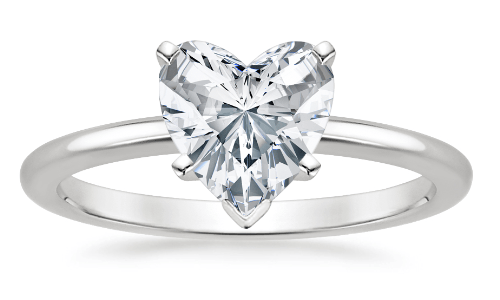
A Heart Cut Diamond Solitaire Ring
Heart Diamonds: A Gift of Romance
Whether marking milestones or expressing pure love, a heart diamond is a timeless gift that reflects cherished moments and promises. Given to a loved one, it becomes a tangible symbol of deep affection, transcending time and materiality to resonate on a soulful level.
This gesture encapsulates enduring sentiment—a testament to the timeless nature of love and the gem’s power to encapsulate profound emotions, shining on into the future.
Celebrities and Heart Cut Diamonds
Celebrities, drawn to the charm of heart cut diamonds, have embraced them both on red carpets and in engagement moments. These gems symbolize love and refinement, gracing fingers and necks, and becoming emblems of star-studded romance that resonate universally.
Investing in Love and Luxury with Heart Diamonds
Heart cut diamonds transcend being mere tokens of affection; they transform into investments that accrue not only sentimental value but also financial worth. As they symbolize love’s depth, they also hold the potential to appreciate in value over time. Just as relationships evolve and deepen, heart diamonds can echo this journey by becoming increasingly cherished and valuable.
While they illuminate the heart, they also illuminate the path toward potential future gains, making them both emotional and pragmatic choices that stand as testament to the enduring nature of love and the artistry of investment.
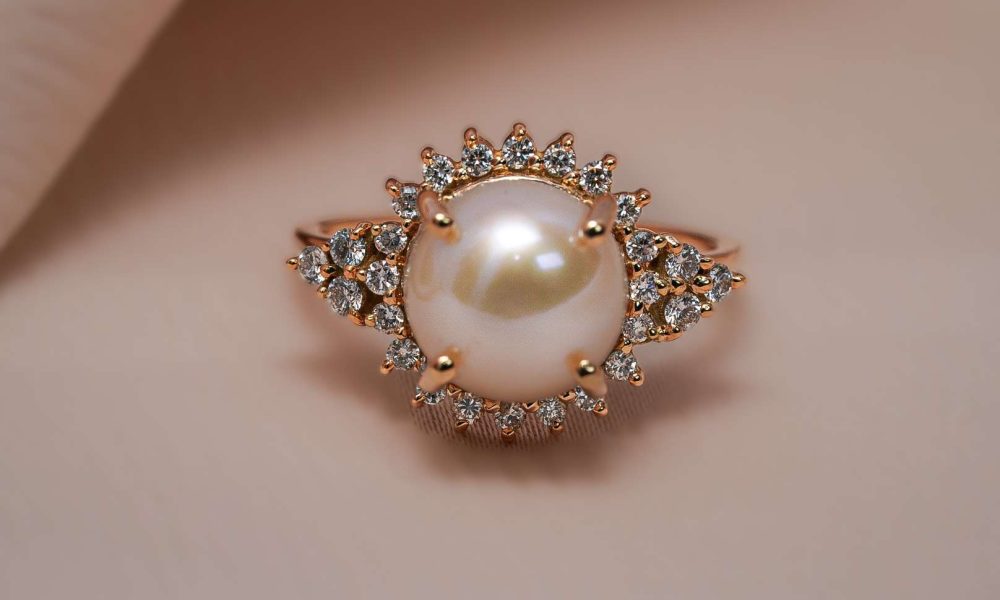
A Gemstone Diamond Ring
Final Thoughts
The heart cut diamond, with its timeless elegance and profound symbolism, stands as a radiant embodiment of love’s myriad facets. Beyond being a gem of unparalleled beauty, it becomes a conduit that communicates emotions that words often fail to capture.
From its meticulously crafted contours to the mesmerizing play of light it orchestrates, the heart diamond enchants with a power that transcends time and trends. Whether adorning engagement rings, necklaces, or earrings, it weaves a narrative of affection and commitment, igniting an everlasting spark that kindles across generations.
With every glance at its intricate form, one is reminded of the cherished moments, promises, and emotions it holds within. In a world where expressions of love take many forms, the heart diamond remains an enduring emblem, reminding us that just as its facets reflect light, our hearts too reflect the boundless luminance of love—a brilliance that remains eternal.
FAQs About Heart Cut Diamonds
A heart cut diamond is a gemstone meticulously shaped to resemble a symmetrical heart, often used in jewelry to symbolize love and affection.
Skilled diamond cutters sculpt the stone into two perfectly symmetrical halves, forming the iconic heart shape. Achieving this requires precision to ensure balanced proportions.
Yes, when well-proportioned, heart diamonds exhibit exceptional brilliance due to their intricate cut that maximizes light reflection and scintillation.
Absolutely, heart cut diamonds have gained popularity as unique and romantic choices for engagement rings, symbolizing a deep emotional connection.
Prong settings are popular as they allow light to enter from various angles, enhancing the diamond's sparkle and radiance.
Yes, heart diamonds can be incorporated into various jewelry designs, from vintage to modern, offering a personalized touch that reflects your style.
Certainly, heart diamonds make exquisite additions to necklaces and pendants, creating a captivating focal point that rests beautifully against the skin.
Yes, heart diamonds can appreciate in both sentimental and financial value over time, making them thoughtful choices that hold lasting significance.
Yes, heart diamonds have charmed celebrities, gracing red carpet events and adorning engagement moments as symbols of refined romance.
Heart diamonds evoke emotions of love, passion, and commitment. They symbolize deep connections and are often chosen to celebrate special milestones in relationships.

